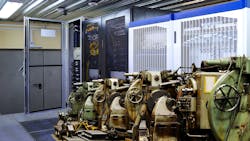By the end of last year, there were an estimated 11.7 billion Industrial Internet of Things devices in the workplace, according to market research firm IIoT Analytics. This is a sure sign machine makers recognize the value of IIoT. But there are also lots of legacy devices still in the field, and companies could benefit by using data collected from these non-IIoT devices. Currently, much of the information available to industrial motors, centrifugal pumps, commercial kitchen equipment, motors, hospital equipment and furnaces just gets lost.
Turning these legacy, non-connected devices into IIoT-enabled machines could give factory manages safety and maintenance several benefits. First, it would let managers and supervisors turn off machines or set them to turn off based on the facility’s operating hours. Another benefit would be determining what a machine’s normal power consumption looks like and comparing that to actual use. If it’s too high or too low, it might indicate the need for maintenance. Managers and supervisors who cannot predict outages or part failures can wind up losing several thousand dollars or more per day while technicians try to diagnose and fix the problem.
For machine makers, there’s a potential revenue stream from legacy machine data: It lets them sell a service contract to monitor the equipment, not only telling the machine owner when to service the equipment, but also providing technicians who can handle the task outside times of peak use and prevent shutdowns during business hours.
Connecting legacy machines to the cloud moves a manufacturer closer to the customer because there’s a stream of data about real-time use. That data, in turn, helps engineering departments design better products. As data streams in from the field, engineers and product development teams can see which features or add-ons are widely used or rarely tapped.
How can machine and equipment builders get actionable data from legacy machines? Among the tools required would be a data transfer protocol such as MQTT, CoAP or XMPP. Programmers designed these for machine-to-machine (M2M), applications.
With a protocol, an AC power connection to a machine and a local Wi-Fi access point, a machine designer could gather and record real-time voltage, current and power factors of the load. That connection could provide high-resolution profiles of the voltage and current wave forms that would let a machine manufacturer track customer use and, in some cases, sign of approaching failure. Engineers could use the on-off cycle counts and powered-on time for the attached load for checking warranty information and exploring preventive maintenance.
A machine maker could also monitor events such as current, voltage, low power factor, temperature and excessive load time. By setting up parameters for these parameters, the company could also use data to trigger user- or manufacturer-defined alerts that sends off texts or emails to notify machine operators or owners in advance of a failure.
Data streamed from a legacy machine connected to the cloud might reduce the cost of supplies or lead to better maintenance. Real-time data could reduce downtime or eliminate trips to remote locations. Making legacy machines internet-ready could save machine owner energy (and money) by turning power on and off as needed, rather than having the machine run constantly. Perhaps most importantly, machine designers and owners could predict failures of parts and anticipate when to schedule maintenance.
Adam Justice is CEO of Grid Connect, Inc.
